12-1338-41
antibody from Invitrogen Antibodies
Targeting: PROM1
AC133, CD133, CORD12, MCDR2, PROML1, RP41, STGD4
Antibody data
- Antibody Data
- Antigen structure
- References [13]
- Comments [0]
- Validations
- Flow cytometry [4]
- Other assay [10]
Submit
Validation data
Reference
Comment
Report error
- Product number
- 12-1338-41 - Provider product page

- Provider
- Invitrogen Antibodies
- Product name
- CD133 (Prominin-1) Monoclonal Antibody (TMP4), PE, eBioscience™
- Antibody type
- Monoclonal
- Antigen
- Other
- Description
- Description: The TMP4 monoclonal antibody reacts with human CD133 (Prominin-1), a 120 kDa member of the pentaspan family of proteins, which also includes Prominin-2. Their expression is found within plasma membrane protrusions such as epithelial microvilli. CD133 can exist in a number of alternatively spliced isoforms, and the protein has several N-linked glycosylation sites: the occurrence of both may be tissue-dependent. Human CD133 was first identified as an epitope expressed on CD34+ hematopoietic progenitors. Although the ligand and function of CD133 remain unknown, it has since proven to be very useful as a marker for both stem cells and cancer stem cells. In addition to its expression on hematopoietic precursors, CD133 has been used to identify tumorigenic colon cancer stem cells, brain cancer stem cells, prostate cancer stem cells, in addition to others. The binding of the TMP4 antibody does not block the binding of another anti-human CD133 antibody, EMK08 (Product # 12-1339) indicating that they recognize distinct epitopes. Applications Reported: This TMP4 antibody has been reported for use in flow cytometric analysis. Applications Tested: This TMP4 antibody has been pre-titrated and tested by flow cytometric analysis of normal human peripheral blood cells. This can be used at 5 µL (0.25 µg) per test. A test is defined as the amount (µg) of antibody that will stain a cell sample in a final volume of 100 µL. Cell number should be determined empirically but can range from 10^5 to 10^8 cells/test. Excitation: 488-561 nm; Emission: 578 nm; Laser: Blue Laser, Green Laser, Yellow-Green Laser. Filtration: 0.2 µm post-manufacturing filtered.
- Reactivity
- Human
- Host
- Mouse
- Conjugate
- Yellow dye
- Isotype
- IgG
- Antibody clone number
- TMP4
- Vial size
- 25 Tests
- Concentration
- 5 μL/Test
- Storage
- 4°C, store in dark, DO NOT FREEZE!
Submitted references Lipogenesis promotes mitochondrial fusion and maintains cancer stemness in human NSCLC.
Human Adult Renal Progenitor Cells Prevent Cisplatin-Nephrotoxicity by Inducing CYP1B1 Overexpression and miR-27b-3p Down-Regulation through Extracellular Vesicles.
Suppression of Cancer Cell Stemness and Drug Resistance via MYC Destabilization by Deubiquitinase USP45 Inhibition with a Natural Small Molecule.
Chemerin enhances the adhesion and migration of human endothelial progenitor cells and increases lipid accumulation in mice with atherosclerosis.
The Deubiquitinase USP4 Stabilizes Twist1 Protein to Promote Lung Cancer Cell Stemness.
Profiling and Targeting of Energy and Redox Metabolism in Grade 2 Bladder Cancer Cells with Different Invasiveness Properties.
SUL-109 Protects Hematopoietic Stem Cells from Apoptosis Induced by Short-Term Hypothermic Preservation and Maintains Their Engraftment Potential.
Inhibition of Fas associated phosphatase 1 (Fap1) facilitates apoptosis of colon cancer stem cells and enhances the effects of oxaliplatin.
ING5 activity in self-renewal of glioblastoma stem cells via calcium and follicle stimulating hormone pathways.
Modified Leukocyte Filter Removes Tumor Cells from the Salvaged Blood.
Evaluation of cancer stem cell markers CD133, CD44, CD24: association with AKT isoforms and radiation resistance in colon cancer cells.
Comparative evaluation of differentiation potential of menstrual blood- versus bone marrow-derived stem cells into hepatocyte-like cells.
Established breast cancer stem cell markers do not correlate with in vivo tumorigenicity of tumor-initiating cells.
Liu Z, Lei J, Wu T, Hu W, Zheng M, Wang Y, Song J, Ruan H, Xu L, Ren T, Xu W, Wen Z
JCI insight 2023 Mar 22;8(6)
JCI insight 2023 Mar 22;8(6)
Human Adult Renal Progenitor Cells Prevent Cisplatin-Nephrotoxicity by Inducing CYP1B1 Overexpression and miR-27b-3p Down-Regulation through Extracellular Vesicles.
Franzin R, Stasi A, De Palma G, Picerno A, Curci C, Sebastiano S, Campioni M, Cicirelli A, Rizzo A, Di Lorenzo VF, Pontrelli P, Pertosa GB, Castellano G, Gesualdo L, Sallustio F
Cells 2023 Jun 17;12(12)
Cells 2023 Jun 17;12(12)
Suppression of Cancer Cell Stemness and Drug Resistance via MYC Destabilization by Deubiquitinase USP45 Inhibition with a Natural Small Molecule.
Tu X, Li C, Sun W, Tian X, Li Q, Wang S, Ding X, Huang Z
Cancers 2023 Feb 1;15(3)
Cancers 2023 Feb 1;15(3)
Chemerin enhances the adhesion and migration of human endothelial progenitor cells and increases lipid accumulation in mice with atherosclerosis.
Jia J, Yu F, Xiong Y, Wei W, Ma H, Nisi F, Song X, Yang L, Wang D, Yuan G, Zhou H
Lipids in health and disease 2020 Sep 20;19(1):207
Lipids in health and disease 2020 Sep 20;19(1):207
The Deubiquitinase USP4 Stabilizes Twist1 Protein to Promote Lung Cancer Cell Stemness.
Li F, Hu Q, He T, Xu J, Yi Y, Xie S, Ding L, Fu M, Guo R, Xiao ZJ, Niu M
Cancers 2020 Jun 15;12(6)
Cancers 2020 Jun 15;12(6)
Profiling and Targeting of Energy and Redox Metabolism in Grade 2 Bladder Cancer Cells with Different Invasiveness Properties.
Pasquale V, Ducci G, Campioni G, Ventrici A, Assalini C, Busti S, Vanoni M, Vago R, Sacco E
Cells 2020 Dec 11;9(12)
Cells 2020 Dec 11;9(12)
SUL-109 Protects Hematopoietic Stem Cells from Apoptosis Induced by Short-Term Hypothermic Preservation and Maintains Their Engraftment Potential.
Aerts-Kaya FSF, Visser TP, Pervin B, Mammadova A, Özyüncü Ö, Wagemaker G, Uçkan-Çetinkaya FD
Biology of blood and marrow transplantation : journal of the American Society for Blood and Marrow Transplantation 2020 Apr;26(4):634-642
Biology of blood and marrow transplantation : journal of the American Society for Blood and Marrow Transplantation 2020 Apr;26(4):634-642
Inhibition of Fas associated phosphatase 1 (Fap1) facilitates apoptosis of colon cancer stem cells and enhances the effects of oxaliplatin.
Huang W, Bei L, Eklund EA
Oncotarget 2018 May 25;9(40):25891-25902
Oncotarget 2018 May 25;9(40):25891-25902
ING5 activity in self-renewal of glioblastoma stem cells via calcium and follicle stimulating hormone pathways.
Wang F, Wang AY, Chesnelong C, Yang Y, Nabbi A, Thalappilly S, Alekseev V, Riabowol K
Oncogene 2018 Jan 18;37(3):286-301
Oncogene 2018 Jan 18;37(3):286-301
Modified Leukocyte Filter Removes Tumor Cells from the Salvaged Blood.
Mei K, Du L, Yan M, Zhang Z, Zhang F, Gong L, Sun K, Zhang J, Tang Y, Jiang C, Liu J
PloS one 2015;10(6):e0130864
PloS one 2015;10(6):e0130864
Evaluation of cancer stem cell markers CD133, CD44, CD24: association with AKT isoforms and radiation resistance in colon cancer cells.
Sahlberg SH, Spiegelberg D, Glimelius B, Stenerlöw B, Nestor M
PloS one 2014;9(4):e94621
PloS one 2014;9(4):e94621
Comparative evaluation of differentiation potential of menstrual blood- versus bone marrow-derived stem cells into hepatocyte-like cells.
Khanjani S, Khanmohammadi M, Zarnani AH, Akhondi MM, Ahani A, Ghaempanah Z, Naderi MM, Eghtesad S, Kazemnejad S
PloS one 2014;9(2):e86075
PloS one 2014;9(2):e86075
Established breast cancer stem cell markers do not correlate with in vivo tumorigenicity of tumor-initiating cells.
Lehmann C, Jobs G, Thomas M, Burtscher H, Kubbies M
International journal of oncology 2012 Dec;41(6):1932-42
International journal of oncology 2012 Dec;41(6):1932-42
No comments: Submit comment
Supportive validation
- Submitted by
- Invitrogen Antibodies (provider)
- Main image
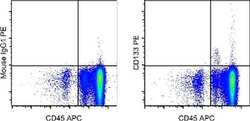
- Experimental details
- Staining of normal human peripheral blood mononuclear cells with Anti-Human CD45 APC (Product # 17-9459-42) and Mouse IgG1 K Isotype Control PE (Product # 12-4714-81) (left) or Anti-Human CD133 PE (right). Total viable cells were used for analysis.
- Conjugate
- Yellow dye
- Submitted by
- Invitrogen Antibodies (provider)
- Main image
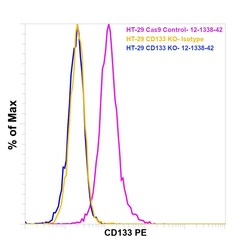
- Experimental details
- Knockout of CD133 was achieved by CRISPR-Cas9 genome editing using LentiArray™ Lentiviral sgRNA (Product # A32042, Assay ID CRISPR924819_LV) and LentiArray Cas9 Lentivirus (Product # A32064). Flow cytometry analysis of CD133 was performed by staining HT-29 CD133 Knock out cells with 0.25 µg Mouse IgG1 kappa Isotype Control (P3.6.2.8.1), PE, eBioscience™ (Product # 12-4714-82, yellow histogram) or 0.25 µg CD133 (Prominin-1) Monoclonal Antibody (TMP4), PE, eBioscience™ (Product # 12-1338-42, blue histogram). HT-29 Cas9 control cells were also stained with 0.25 µg CD133 (Prominin-1) Monoclonal Antibody (TMP4), PE, eBioscience™ (Product # 12-1338-42, pink histogram). Loss of signal was observed in the CD133 KO cells stained with anti-CD133 antibody clone TMP4 but not in the control Cas9 cells. Fixable Viability Dye eFluor 780 (Product # 65-0865-18) was used for staining and selecting viable cells for analysis.
- Conjugate
- Yellow dye
- Submitted by
- Invitrogen Antibodies (provider)
- Main image
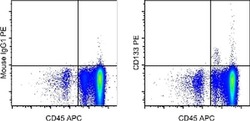
- Experimental details
- Staining of normal human peripheral blood mononuclear cells with Anti-Human CD45 APC (Product # 17-9459-42) and Mouse IgG1 K Isotype Control PE (Product # 12-4714-81) (left) or Anti-Human CD133 PE (right). Total viable cells were used for analysis.
- Submitted by
- Invitrogen Antibodies (provider)
- Main image
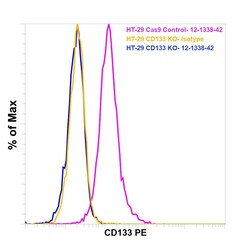
- Experimental details
- Knockout of CD133 was achieved by CRISPR-Cas9 genome editing using LentiArray™ Lentiviral sgRNA (Product # A32042, Assay ID CRISPR924819_LV) and LentiArray Cas9 Lentivirus (Product # A32064). Flow cytometry analysis of CD133 was performed by staining HT-29 CD133 Knock out cells with 0.25 µg Mouse IgG1 kappa Isotype Control (P3.6.2.8.1), PE, eBioscience™ (Product # 12-4714-82, yellow histogram) or 0.25 µg CD133 (Prominin-1) Monoclonal Antibody (TMP4), PE, eBioscience™ (Product # 12-1338-42, blue histogram). HT-29 Cas9 control cells were also stained with 0.25 µg CD133 (Prominin-1) Monoclonal Antibody (TMP4), PE, eBioscience™ (Product # 12-1338-42, pink histogram). Loss of signal was observed in the CD133 KO cells stained with anti-CD133 antibody clone TMP4 but not in the control Cas9 cells. Fixable Viability Dye eFluor 780 (Product # 65-0865-18) was used for staining and selecting viable cells for analysis.
Supportive validation
- Submitted by
- Invitrogen Antibodies (provider)
- Main image
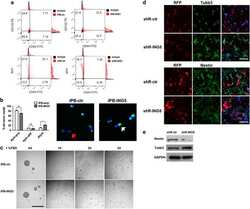
- Experimental details
- NULL
- Conjugate
- Yellow dye
- Submitted by
- Invitrogen Antibodies (provider)
- Main image
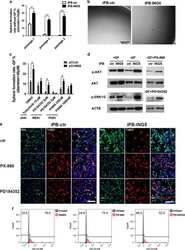
- Experimental details
- NULL
- Conjugate
- Yellow dye
- Submitted by
- Invitrogen Antibodies (provider)
- Main image
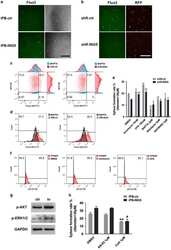
- Experimental details
- NULL
- Conjugate
- Yellow dye
- Submitted by
- Invitrogen Antibodies (provider)
- Main image
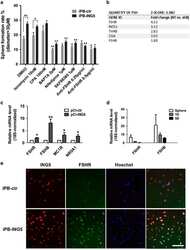
- Experimental details
- NULL
- Conjugate
- Yellow dye
- Submitted by
- Invitrogen Antibodies (provider)
- Main image
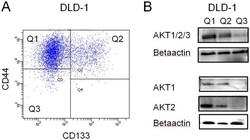
- Experimental details
- Figure 3 AKT expression in CD133/CD44 sorted cells. A) DLD-1 cells were sorted by flow cytometry and different populations with CD44 positive /CD133 negative (Q1), CD44 positive /CD133 positive (Q2), CD44 negative CD133 negative (Q3), were collected. B) The sorted cells were further analyzed with western blot for total AKT, AKT1 or AKT2 and betaactin expression.
- Conjugate
- Yellow dye
- Submitted by
- Invitrogen Antibodies (provider)
- Main image
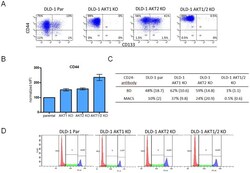
- Experimental details
- Figure 4 Flow cytometry analysis of the expression of CD133, CD24 and CD44 in the colon cancer cell-line DLD-1 with its isogenic knock-out cell-lines of AKT 1, AKT 2 and AKT 1/2. A) In the parental cells, approximately 10% of the cells were CD133 positive cells. However, in the AKT 1 and AKT 1/2 knock-outs, the CD133 positive cells were reduced to 0.3 and 0.1% respectively. This was not seen in the AKT 2 knock-out cell-line, where 33% of the cells were positive for CD133. B) The mean fluorescent intensity of CD44 normalized to the DLD-1 parental cell-line increased to 150% in AKT 1 KO, 160% in AKT 2 KO and 300% in AKT 1/2 KO cell-line. The error bars represent the standard deviation (SD) from at least two experiments. C) The percent of CD24 positive cells analyzed with two different CD24 antibodies from BD Biosciences and Miltenyi/MACS in flow cytometry. The standard deviations are from repeated experiments. D) Cell-cycle distribution in DLD-1 parental, AKT 1 KO, AKT 2 KO and AKT 1/2 KO cells.
- Conjugate
- Yellow dye
- Submitted by
- Invitrogen Antibodies (provider)
- Main image
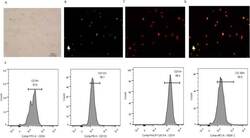
- Experimental details
- Fig. 1 Identification of EPCs. a Adherent cells grew in a blood island manner. Fluorescent staining of EPCs. b Adherent cells took up UEA-1-lectin. c Adherent cells took up Dil-Ac-LDL. d Adherent cells took up UEA-1-lectin and Dil-Ac-LDL. E. Surface molecular markers of EPCs. Adherent cells expressed CD34, CD133, CD14 and VEGFR-2. All experiments involving cell culture studies were repeated three times with three replicates per experiment
- Conjugate
- Yellow dye
- Submitted by
- Invitrogen Antibodies (provider)
- Main image
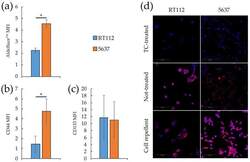
- Experimental details
- Figure 2 Stemness markers of monolayers and spheroids from RT112 and 5637 cells. ( a - c ) Median fluorescence intensity of Aldefluor TM ( a ), CD44 ( b ) and CD133 ( c ) by flow cytometry analysis on RT112 and 5637 cells grown as monolayers. Results are the mean of two ( a ) and three ( b , c ) experimental replicates. Statistical test: t -test, * for p < 0.05. ( d ) Representative images from confocal immunofluorescence (IF) microscopy of RT112 and 5637 cells using SOX2 Antibody (red) and Hoechst 33342 (blue) for nuclei. Cells were grown as monolayer or spheroids on different (Tissue culture-treated, Not-treated or Cell repellent) supports, before being seeded in adherent condition on chamber slides for IF.
- Conjugate
- Yellow dye
- Submitted by
- Invitrogen Antibodies (provider)
- Main image
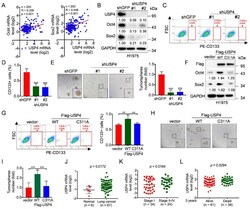
- Experimental details
- Figure 1 USP4 promotes lung cancer cell stemness and its high expression is correlated with human lung cancer patients. ( A ) The Oncomine dataset ""Bhattacharjee Lung"" was used to analyze Pearson correlation of USP4 and Oct4/Sox2 expression. ( B - E ) H1975 cells stably expressing shRNA against USP4 (shUSP4-#1 or shUSP4-#2) were subjected to ( B ) Western blot analyses, ( C - D ) FACS analyses for CD133-stained cells or ( E ) tumorsphere formation assay. Respective images and quantitation were shown. Data from three independent experiments in triplicates were presented as means +- SD. *** p < 0.001. Scale bar = 100 mum. ( F - I ) H1975 cells stably expressing Flag-USP4 or Flag-USP4 C311A were subjected to ( F ) Western blot analyses, ( G ) FACS analyses for CD133-stained cells or ( H - I ) tumorsphere formation assay. Respective images and quantitation were shown. Data from three independent experiments in duplicates were presented as means +- SD. ** p < 0.01, *** p < 0.001. Scale bar = 100 mum. ( J ) The Oncomine dataset ""Gaber lung"" was used to analyze USP4 mRNA levels in normal human lung tissues and lung cancers. ( K ) The Oncomine dataset ""Bild lung"" was used to analyze USP4 mRNA levels in stage I or stage II-IV human lung cancers. ( L ) The Oncomine dataset ""Raponi lung"" was used to analyze USP4 mRNA levels in 3 year-alive or 3 year-dead human lung cancer patients.
- Conjugate
- Yellow dye
- Submitted by
- Invitrogen Antibodies (provider)
- Main image
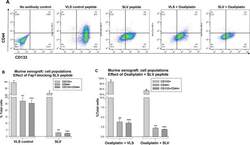
- Experimental details
- Figure 5 Fap1-inhibition decreases abundance of CD133 + CD44 + cells in in a murine xenograft model of colon cancer with or without oxaliplatin Tumors from the mice described above were analyzed for cell population distribution after various treatments. (A) Histograms from flow cytometry demonstrate decreased abundance of CD133 + CD44 + cells after treatment with SLV peptide with or without oxaliplatin. A representative histograms for each cohort is shown. (B) Treatment with SLV peptide decreases relative abundance of CD133 + CD44 + cells in xenograft tumors. Tumors were simultaneously harvested from mice treated with SLV peptide versus VLS control (when control group tumors were >2,000 mm 3 ) and analyzed for CD133 and CD44 expression by flow cytometry. Significant differences indicated by * , ** , or *** . (p2,000 mm 3 ) and analyzed for CD133 and CD44 expression by flow cytometry. Significant differences indicated by * , ** , or *** . (p
- Conjugate
- Yellow dye
 Explore
Explore Validate
Validate Learn
Learn Flow cytometry
Flow cytometry